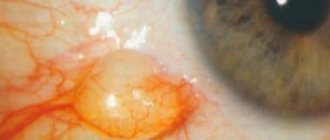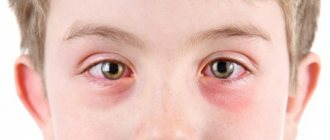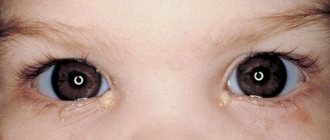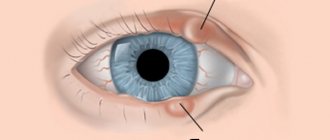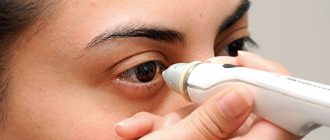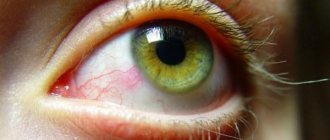Epidemic keratoconjunctivitis Pharyngoconjunctival fever Our advantages Treatment price
Adenoviruses are the cause of external eye infections. Syndromes of adenoviral infections are expressed by epidemic keratoconjunctivitis (EKC) and pharyngoconjunctival fever (PFC).
Typically, patients demonstrate clinical symptoms of one of these syndromes, but sometimes they have distinctive features that are not characteristic of these diseases. Infections of the external eye caused by adenovirus are acute and self-limiting, but there are also chronic processes. The disease can occur in two main clinical forms: epidemic keratoconjunctivitis (EK) and pharyngoconjunctival fever (PKF).
Etiology
The cause of the pathology can be several factors:
- Pathogenic bacteria;
- Viruses and fungi;
- Parasitic infections;
- Allergy;
- Use of corticosteroids;
- Foreign body in the cornea or conjunctiva;
- Lack or excess of vitamins.
In some cases, the disease can be caused by improperly wearing contact lenses or touching the eyes with dirty hands. Some diseases can also “activate” keratoconjunctivitis, these include:
- Flu;
- Rubella;
- Lupus erythematosus;
- Rheumatoid arthritis, etc.
Causes of dry eye syndrome
External causes of dry eye syndrome are especially relevant for people under 45 years of age:
- exposure to conditioned air,
- prolonged work at the computer and other office equipment,
- electromagnetic radiation,
- polluted air, smoke, smog,
- laser operations,
- cosmetics,
- incorrect selection or use of contact lenses
At older ages, internal factors become more relevant:
- hormonal disorders (menopause),
- general health, metabolic characteristics,
- accompanying illnesses,
- psychological factors,
- hypovitaminosis.
Classification of keratoconjunctivitis
Like most diseases, this pathology is divided into acute and chronic forms. The first type has pronounced symptoms, often accompanied by an increase in body temperature.
If treatment is delayed, sooner or later the acute infection will be “reclassified” as chronic, which affects the deep structures of the eye and can affect other systems in the body. The disease, which occurs with complications, leads to decreased visual acuity or blindness. There are several types of keratoconjunctivitis, they are classified depending on the causes of the disease.
Dry eye syndrome
Pathology is considered the “plague” of the twenty-first century; it is encountered by those who spend a lot of time at the computer or watching TV. Also at risk are people who suffer from allergies and use contact lenses. Scientists still cannot figure out what exactly triggers the development of the disease. The main causes of keratoconjunctivitis sicca include:
- Malfunction of the lacrimal glands;
- Liquid quickly evaporates from the cornea, even if the glands are functioning normally;
- Having a disease that causes problems with tear production.
The disease develops in several stages, each of which is accompanied by specific symptoms:
- In the first stage, redness of the eyes is observed. A secretion accumulates in the conjunctival sac, resembling strings in appearance;
- In the second, the epithelium on the cornea is detached, the eyelids swell;
- On the third, erosions appear, threads up to five millimeters long hang from the cornea. When a person tries to open his eyes, they tear and cause unbearable pain;
- On the fourth, corneal keratosis and blurred vision are observed.
To treat pathology, special drops are used to replace tear fluid. In some cases (if there are complications), the doctor prescribes ointments or lubricants. To speed up the recovery process, it is recommended to drink a complex of vitamins.
You can learn more about dry eye syndrome by watching the video
Return to contents
Allergic form
There are several varieties:
- Spring, appears only during the flowering period of plants;
- All-season, usually caused by household dust, animal hair and other persistent allergens;
- Medicinal, the cause of its “activation” is certain types of eye drops.
Characteristic signs are increased lacrimation, pain, redness of the whites, swelling of the eyelids.
Regardless of the form, the onset of the disease is caused by an allergen irritant. Each specific case is different; identifying the “pest” is very difficult, especially for all-season keratoconjunctivitis. To do this you will need to pass a number of special tests.
Most often, treatment consists of eliminating the source of the disease. To get rid of puffiness, it is recommended to use Tobradex drops.
Viral keratoconjunctivitis
The most dangerous type of pathology, since viruses can cause a real epidemic. The main signs of the disease are:
- Redness of the eyes;
- Purulent discharge;
- Crust formation;
- Fear of light and pain.
There are several types of infectious keratoconjunctivitis.
Herpetic
Appears as a result of the pathogenic microorganism herpes getting into the eyes. In this case, therapy cannot be done without the use of antiviral medications such as Interferon.
Doctors also recommend using Acyclovir ointment and Diclofenac injections. To prevent illness, take a course of antibiotics.
Epidemic
The most dangerous type of viral keratoconjunctivitis. The cause of the disease is adenoviruses transmitted by airborne droplets. If a pathology is detected, the infected person must be immediately isolated from the rest of the family, especially if there is a small child in the house. The incubation period lasts one week.
| The patient must be provided with individual personal hygiene items, ventilate the room every day, and wash your hands often with soap. To wash your eyes, use disposable swabs; when instilling the medicine, make sure that the tip of the pipette does not touch the mucous membrane. |
The disease is very difficult in children; you can often find a whole group in kindergarten affected by this disease. Poludan drops are used to treat epidemic keratoconjunctivitis, and Ketotifen helps with swelling. In some cases, doctors prescribe Zovirax. Take a course of vitamin A. Return to contents
Adenoviral pathology
Caused by pathogenic bacteria that live in our body. As a rule, the patient first develops pharyngitis, and only then does keratoconjunctivitis develop. The disease is transmitted by airborne droplets; an infected person is dangerous to others for seven days.
If pathology is detected in children, consult a doctor immediately, as it can cause serious complications such as sore throat, loss of vision, pneumonia or otitis media.
For treatment, the same medications are used as to combat epidemic keratoconjunctivitis.
Chlamydial
It occurs as a result of stagnant tears in the eyes and the formation of entire colonies of fungi, which are the source of the disease. As therapy, doctors prescribe a course of antifungal medications, vitamins and drugs to strengthen the immune system.
Tuberculosis-allergic
Its second name is the phlyctenular form of keratoconjunctivitis. It is the body’s “response” to tuberculosis. Characteristic signs are the appearance of whitish nodules on the mucous membrane of the eyes or cornea, which gradually turn into ulcers.
Therapy
Therapy must be comprehensive. Depending on the type of keratoconjunctivitis, tablets, drops and ointments are prescribed. In particularly advanced cases, surgical intervention is performed.
Drugs
For treatment, not only local medications are prescribed, but also systemic drugs. Along with the use of medications, you need to be especially careful about eye hygiene.
| Type of keratoconjunctivitis | Pills | Ointments | Drops |
| Allergic | Antihistamines: Allergodil and Levocabastine Glucocorticosteroids: Dexamethasone, Prednisolone | ||
| Herpetic | Acyclovir | Zovirax, Zigran, Trigerpit, Prednisolone | |
| Adenoviral | Oxolinic, Tebrophenic | Dexamethasone | |
| Epidemic | Oxolinic, Tebrophenic | Drops with interferon | |
| Dry | Systane-Balance and Oftagel | Low viscosity products: Visine pure tear and Oksial Medium viscosity products - Systane-Ultra | |
| Chlamydial | Tsiprolet, Sumamed, Fromilid | Tetracycline and Erythromycin | |
| Tuberculosis-allergic | Isoniazid, Streptomycin and Rifampicin | Hydrocortisone | Dexamethasone. |
You can use medications only as prescribed by a doctor. It determines the dosage and duration of the therapeutic course.
Surgery
Keratoplasty is performed when the cornea is completely damaged. The operation consists of restoring clouded tissue when it is impossible to restore its transparency.
There are 3 methods of transplantation: superficial and deep. In the first case, the 2 upper layers are replaced, and in the second, the inner layer is replaced. Complete corneal replacement is called penetrating keratoplasty.
REFERENCE. During surgery, the doctor can remove cataracts or restore the normal structure of the eye after injury.
The operation is performed under local anesthesia. After this, daily inclusion of the eye is required. During the recovery period, the patient should use antibiotics and anti-inflammatory drops.
Folk remedies
Folk remedies for keratoconjunctivitis can be used as additional ones and only after consultation with a specialist. Effective folk recipes:
- Milk compress. Cotton pads should be soaked in cold milk and placed on the eyelids. They must be held for 15 minutes.
- Chamomile decoction. To prepare you will need 1 glass of water and 1 tbsp. daisies. The medicine must be brought to a boil and left for 1 hour. The resulting product is used to wash the eyes.
- Honey drops. In 200 ml of boiled cold water you need to put 1 tsp. honey. Drops are used 1 drop 2 times a day.
First you need to do a test for individual tolerance to a component of a home remedy. If side effects occur, you should stop using folk remedies.
Symptoms
Each type of disease has its own characteristics. However, there are several symptoms that are observed with any form of keratoconjunctivitis. These include:
- Burning and itching in the eyes;
- Redness of the cornea;
- Loose structure of the conjunctiva;
- Increased lacrimation;
- Fear of bright light;
- Feeling as if there is a foreign object in the eyes;
- Purulent and mucous discharge;
- Swelling.
With sepsis, the formation of pathological elements such as follicles is sometimes observed. Initially, the inflammation affects only the conjunctiva, but after five, maximum fifteen days it spreads to the cornea.
If the cause of the disease lies in chlamydia, then the formation of subepithelial infiltrates is added to the listed symptoms. In the epidemiological form, clouding of the cornea is observed. Return to contents
Treatment of dry keratoconjunctivitis is long-term, sometimes lifelong.
The key to success in treatment is to determine the root cause of the disease. However, it is necessary to resort to drug treatment, which includes:
- use of eye moisturizers;
- antibiotic therapy;
- anti-inflammatory therapy, etc.
In case of systemic disorders, courses of vitamin therapy and regulation of the animal’s hormonal levels are used.
In advanced cases, surgical intervention is performed to reposition the duct of the parotid salivary gland in order to moisturize the eye. Return to list
Diagnostics
It is carried out in order to identify the cause of the pathology. Diagnosis begins with an examination of the organ of vision; at this stage, the ophthalmologist can make a preliminary diagnosis. Since in the initial stage the disease has symptoms similar to conjunctivitis and keratitis.
At the second stage, the doctor checks the patient’s visual acuity; this is necessary to assess the extent and depth of damage to the cornea. If the disease has affected the deeper layers, the risk of serious complications, including blindness, increases.
| Additionally, perimetry is performed to assess the visual field. This study is one of the mandatory procedures, since keratoconjunctivitis often causes clouding of the cornea, which can significantly reduce the field of vision. |
In the case of a bacterial form of pathology, a smear is taken for the flora. With its help, specialists determine to which species and group the causative agent of the disease belongs. This is necessary in order to select effective therapy.
To diagnose viral keratoconjunctivitis, a PRC analysis is performed, and the titer of antibodies to pathogens is measured. An increased rate indicates that this particular bacterium has become “the culprit of all troubles.”
In addition, you will need to undergo general tests to assess the patient’s health status.
Features of treatment
After identifying the cause of the disease, therapy is prescribed; it is individual for each form of keratoconjunctivitis. Use any medication only after confirming the diagnosis and determining the type of “pest”. If the symptoms are mild, you can get by with drops and ointments that give short-term results. They eliminate redness, itching and burning; some drugs destroy pathogenic microorganisms.
If the disease rapidly develops, it is necessary to add antibacterial, antiviral or antifungal agents to the “diet” of treatment.
| Remember that uncontrolled use of medications can worsen your condition and cause serious health problems. |
If the cause of the pathology is a foreign body that has entered the eye, then surgery cannot be avoided. Typically, conservative treatment is sufficient to combat keratoconjunctivitis, but if it does not provide the desired result, the doctor will refer the patient for a corneal transplant.
Recommended medications
Before using any drug, consult your doctor. Remember that any medicine has contraindications.
Oftalmoferon helps fight viruses and strengthens the immune system. For acute forms of the disease, use drops six to eight times during the day. As the condition improves, reduce the number of instillations to two to three times.
Tobrex is an antibiotic from the aminoglycoside group. For corneal sepsis, instill 1-2 drops into the conjunctival sac six to eight times a day. As symptoms disappear, reduce the dose to four or five instillations.
Ciprofloxacin is a medicine to combat pathogenic microorganisms. For mild inflammatory processes, it is enough to instill 1-2 drops of the drug every four hours; in case of complications, use the drug every two hours.
To prevent secondary infection, a solution of chloramphenicol (0.25%) or sodium sulfate (30%) is recommended. Return to contents
Complications
Against the background of inflammatory processes, clouding of the cornea often occurs. This symptom requires immediate treatment, as it can cause vision impairment. A thorn forms on the eye, covering part of the eyeball. Some forms of opacification require immediate surgical intervention.
The disease may also be accompanied by complications such as:
- Scar formation on the mucous membrane;
- Otitis;
- Transition of pathology from acute to chronic form;
- Blindness;
- Bacterial damage.
| To avoid complications with keratoconjunctivitis, it is important to consult a doctor in a timely manner. |
Xerophthalmia and contact lenses: is there a connection?
Many wearers of contact optics are faced with the phenomenon of dry eyes. You can keep the containers sterile, remove your lenses at night, and wash them in a special solution, but this will not save you from dryness and discomfort. When wearing contact optics, dry eye syndrome occurs for several reasons:
- Violation of the wearing regime, the period for replacing lenses. Wearing contact lenses longer than prescribed, sleeping in lenses not intended for 24-hour use leads to the development of xerophthalmia.
- Incorrect lens fit. When contact optics do not fit well on the eye, the circulation of tear fluid is disrupted, which leads to drying out of the mucous membrane of the eye.
- Unsuitable lens care products. Some multi-purpose solutions lack moisturizing ingredients. Therefore, the lenses dry out quickly, which leads to the development of xerophthalmia.
If any symptoms of a pathological condition appear, you should immediately contact an ophthalmologist. The doctor will conduct the necessary diagnostics, determine the causes of dry eye development and prescribe adequate treatment.
Prevention
To reduce the risk of contracting an infection, take medications that strengthen the immune system; they activate the body’s protective functions and help it fight pests more effectively.
It is important to observe the rules of personal hygiene and promptly treat any illnesses. Try to minimize contact with substances that cause an allergic reaction.
Use eye drops that contain blueberry extract. They speed up the metabolic process in the body and promote rapid recovery.
